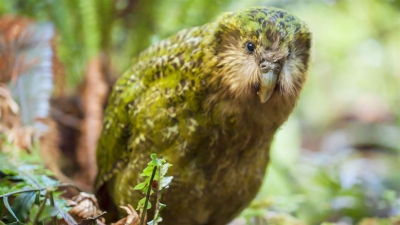
The kakapo is a large flightless parrot native to New Zealand. It adapted to life on the ground because New Zealand has few natural terrestrial predators. They are accomplished climbers, using their wings for balance, and their beak and strong claws to pull and grip their way up and down trees.
Once found throughout New Zealand, kakapo started declining in range and abundance after the arrival of Maori. They disappeared from the North Island by about 1930, but persisted longer in the wetter parts of the South Island. The last birds died out in Fiordland in the late 1980s. A population of less than two hundred birds was discovered on Stewart Island in 1977, but this population was also declining due to cat predation. During the 1980s and 1990s the entire known population was transferred to Whenua Hou/Codfish Island off the coast of Stewart Island, Maud Island in the Marlborough Sounds and Hauturu/Little Barrier Island in the Hauraki Gulf. Since then birds have been moved between Whenua Hou, Maud Island and Hauturu, as well as to and from newly predator-free Chalky and Anchor Islands in Fiordland. Kakapo now occurs only on forested islands, though they previously appeared to have inhabited a wide range of vegetation types.
Kakapo breeds in summer and autumn, but only in years of good fruit abundance. On islands in southern New Zealand they breed when the rimu trees fruit, which is once every 2 to 4 years. Elsewhere in New Zealand they probably nested when southern beech seeded, but the triggers for breeding in some northern places, including Hauturu, are unknown.
Kakapos are lek breeders. Males call from track-and-bowl systems to attract females for mating. Males play no part in incubation or chick-rearing. The nests are on or under the ground in natural cavities or under dense vegetation. The 1-4 eggs are laid in a shallow depression in the soil or rotten wood, which is repeatedly turned-over before and during incubation.
Picture Credit : Google



